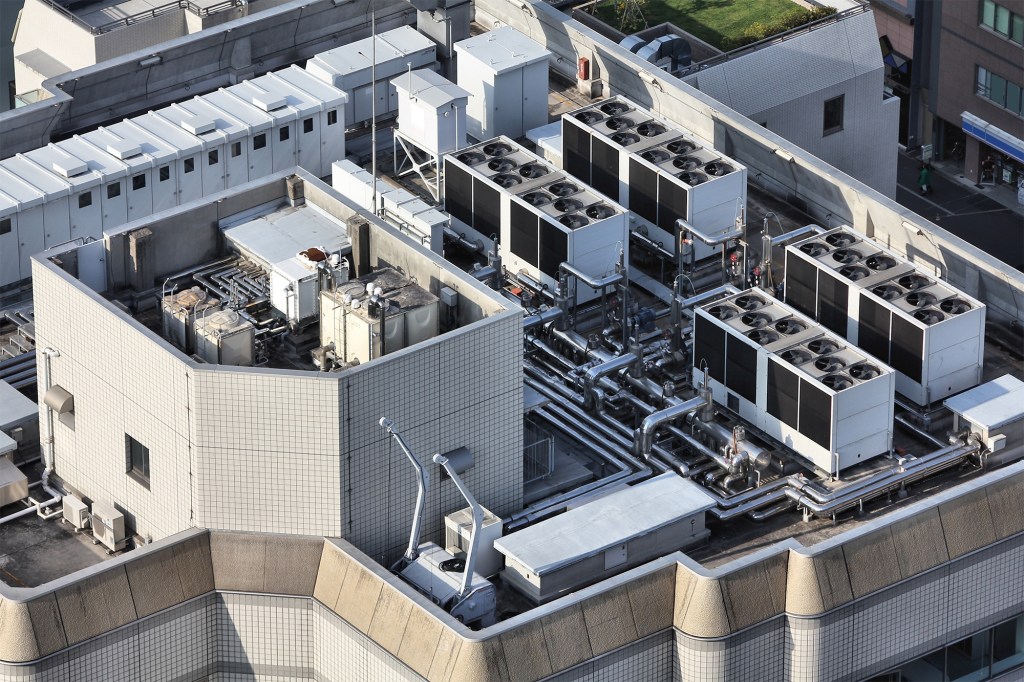The world is rapidly cooling. Not outside, mind you, but inside.
The use of air conditioning and refrigeration is accelerating as the planet warms. According to a May 2018 International Energy Agency (IEA) report, worldwide demand for air conditioning will likely triple by 2050. “The global stock of air conditioners in buildings will grow to 5.6 billion by 2050, up from 1.6 billion today—which amounts to 10 new ACs sold every second for the next 30 years,” the report states. Because AC units and refrigerators emit hydrofluorocarbons, a pollutant associated with climate change, these cooling devices are contributing to what the Washington Post reporter Jason Samenow calls our “red-hot planet.” And, the hotter the Earth, the more air conditioning we will use, resulting in an even hotter planet, and so on.
As the overseers of buildings, architects now find themselves on the front lines of two battles: one to mitigate the effects of an increasingly extreme climate on occupants, and another to reduce the deleterious influence buildings can have on the planet. Naturally, passive design strategies that increase shade and ventilation during summer months are a given, but they will not satisfy the global demand for cooling. Given the role of the built environment in the dissemination and use of cooling, it is worth looking at emerging technological solutions to this compounding problem.
One commonsense approach is to increase the insulating capacity of building envelopes. Conventional insulating products have witnessed some performance gains, but improvements remain modest. Scientists point to vacuum insulation technology as a potential disruptor. Made of a low-e gas barrier enclosing a porous core material, vacuum insulation panels (VIPs) are designed to reduce the influence of heat transfer by conduction and convection. The result is an incredibly thin, ultra-high performance material: A 1-inch-thick, VIP offers an insulation rating of R-25 or greater as compared to the R-3 to R-6 rating of conventional products.

Dow Corning manufactures VIPs that can achieve an impressive R-39 per inch. At thicknesses between 0.25 inch to 1.5 inches, such a material offers not only radical thermal performance but also a significant reduction in envelope depth. The caveat? VIPs are expensive and must be handled with great care: one puncture and a panel may be rendered worthless. Nevertheless, VIPs’ tremendous benefits have inspired some researchers to describe the technology as a “historic opportunity for the building construction industry.”
Also taking a biomimicry route is a group of ETH Zurich scientists investigating how to imbue building envelopes with the evaporative cooling powers of sweating as a way to mitigate heat transfer to the interior. The researchers have developed a thermoresponsive hydrogel surface called PNIPAM that is sandwiched between PVC foil and a polycarbonate membrane and installed on building roofs. The composite is designed to be saturated with rainwater—an abundant resource in tropical regions—that “sweats” out when the surface is exposed to the sun, extracting heat from the building, and reducing the need for air conditioning. According to the scientists, a single detached house in the tropics covered with a PNIPAM roof could reduce its annual energy consumption by 220 kilowatts per hour—equivalent to approximately 309 pounds of carbon dioxide—and cut its energy bill by more than half. “For other climates, future material developments may target polymers that can absorb humidity at night, and thus slowly re-load independent of precipitation,” the researchers suggested.
Radiative cooling, another heat-reduction method, entails sending the emission of heat within a specific portion of the infrared spectrum into the upper atmosphere, thus enabling a surface to achieve a temperature lower than the ambient air. Given the narrow frequency band within which radiative cooling is operable, the process is difficult to attain. However, renewable cooling and refrigeration systems company SkyCool Systems, founded by a former Stanford University researcher, has developed a reflective panel designed to redirect this range of infrared light—as well as 97 percent of sunlight—back into the sky. Under the midday sun, the material remains 8.82 F cooler than the surrounding air—the equivalent of 40 watts per square meter of cooling power. By incorporating piped water beneath the panels, SkyCool Systems suggests that its technology can replace or enhance the condenser element in existing air conditioning equipment, making the technology particularly advantageous for building retrofits. If widely applied, the company’s radiative cooling technology could reduce between 10 and 20 percent of air conditioning-based energy consumption in the U.S., according to a 2012 Advanced Research Projects Agency-Energy study.
Like many new technologies, these emerging materials and systems require additional development and testing before widespread deployment. Furthermore, cost is likely to remain a fundamental factor, thus limiting early adoption. Nevertheless, the extraordinary potential benefits of these offerings—and the palpable momentum driving their development—indicate that the building envelope remains fluid territory for technical experimentation and advancement.
